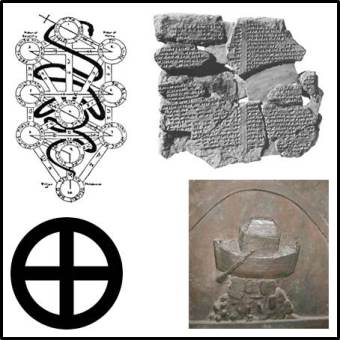THE TAKE AWAY
The Inspiration for the Noah Movie
By Kersley Fitzgerald


Single Page/Printer Friendly

So, I was on a short vacation the day the Got Questions staff saw Noah. It didn't break my heart — I have this strange visceral reaction when faced with a movie based on the Bible. I've never seen the Jesus film, or The Passion of the Christ. I watched very little of The Bible miniseries. If cucumbers, tomatoes, and grape slushies aren't involved, I tend to stay away. It's a personal conviction (or quirk), though, and it isn't coherent enough for me to categorically condemn all Bible-based fiction.
I've read lots of reviews about Noah, though. I read Aronofsky say it wasn't very biblical and that he relied heavily on the Jewish custom of Midrash — to consider what isn't there. The more I heard about the movie, the more I suspected there was something else going on. Not malicious, per se, but no story comes out of a vacuum. And if parts of the story weren't from the Bible, where did they come from?
The tipping point was the rock monsters. I don't know much about Kabbalah, but I do know there's a creature called a "golem," made of animated earth. Sounded familiar.
Noah and Gnosticism
My suspicions were affirmed by Dr. Brian Mattson's article "Sympathy for the Devil." He confirmed the influence of Kabbalah and, even more, Gnosticism, which basically says spirit is good and material is evil.
First a bit about the Gnostic creation story. In Gnosticism, the earth was not created by the supreme, unknowable god. There are several myths, but the one I'm most familiar with says the supreme god created several other spiritual beings ("aeons") with a piece of his divine "fullness." One of these was the goddess of wisdom, Sophia. These beings, particularly Sophia, had within them that part of the supreme god's nature that induced them to create. Sophia created (or gave birth to) the Demiurge. He had a portion of his mother's power, but being a step further from the supreme god, he was an abomination. Sophia hid him. He knew no one but himself. But that divine bit of nature he received from Sophia induced him to create. Being a lesser entity, his creation was even further removed from the supreme god. So far removed that it introduced the material to the cosmos. He couldn't even perceive the spiritual realm, but some of Sophia's power was endowed to his physical creation. Which is why people are comprised of his wretched physicality and his mother's divine spirituality. The goal of Gnosticism is to awaken Sophia's divine spark in all of us so we can shed our physical nature and, as pure spiritual energy, join the supreme god.
Gnosticism is taken from the Greek gnosis, or divine knowledge. That is, the awareness of the divine spark in us. This can only occur through secret knowledge or awareness.
In classical Platonism, Sophia has pity on her creation's creation and endows humans with light — knowledge of the divine (although different people have different levels of awareness). To make matters more confusing, when the Old Testament was translated into Greek in the Septuagint, the word sophia was used for "wisdom" in the poetic books. There is also some cross-cultural usage with the Greek logos in the New Testament. Despite the confusion, the Greek Sophia is not equivalent to the biblical concept of wisdom.
Mattson adequately explained why Noah could think the creator would want all the people wiped out. The physical and the deeds done by the physical are evil, and only by escaping the physical world could the spark — the small bit of divine spirit — return to the supreme god.
Noah and Extra-Biblical Judaism
There are several versions of Kabbalah, but Gnosticism runs deep here, too. Rabbi Isaac Luria (1534-1572) teachings, which either formed or explained the basis of modern Kabbalah, say the earth is several levels from the divine being. Mattson points out that Sophia's manifestation in Noah was the snake, who revealed the wisdom of God. Genesis 3:1 describes the serpent as "subtle" or shrewd and crafty. While in the Bible the serpent is associated with the Tree of the Knowledge of Good and Evil, in Kabbalist philosophy, it also winds around the Tree of Life, which represents the levels of creation and illustrates how far the physical world is from the divine creator.
Confusing, but a bit more enlightenment on how a snake skin could reveal hidden knowledge to a user.
Identifying angels as "Watchers" comes to Kabbalah via Daniel 4:13, 17, and 23. "Watcher" is the name Nebuchadnezzar gives to the angels who warn him he will live like a beast. The apocryphal book of Enoch calls all angels, including the fallen, "watchers." Enoch expands on the rather anemic depiction in Genesis 6:1-4 to say that Semyaza and others fell and became demons when they lusted after human females, mated with them, and begot the giant Nephilim who ate humans, which I understand is hinted at in the movie. Rameel, perhaps better known as Azazel, fell when he taught men how to make weapons and cosmetics (perhaps the patron of Tubal-Cain, "forger of all instruments of bronze and iron" (Genesis 4:22)?).

Continue to Page Two
Images; clockwise from top right: Kabbalah Tree of Life with serpent; Epic of Gilgamesh tablets, Noah's Ark from the Cathedral of Speyer, Gnostic symbol.
comments powered by Disqus
Published 3-31-2014

